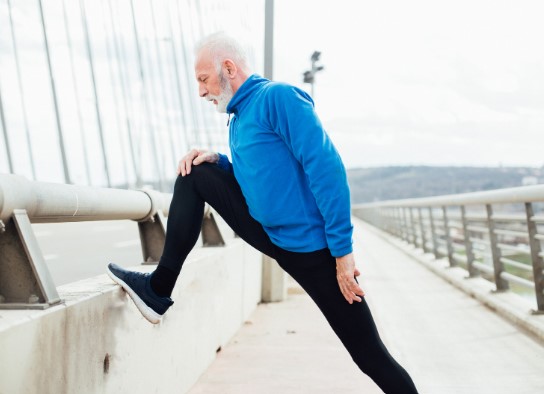
Overall, hip prosthesis implantation is one of the most successful operations of all, especially with regard to successful pain treatment and restoration of function
The right amount of self-therapy
Carry out the exercises instructed in hospital on your own 2-3 times a day, adapted to your pain. The brochure provided will help you with this. Go for regular walks and continuously increase the distance, stride length and walking speed. At home, try to increasingly leave your walking sticks behind and take a few steps without walking aids. Here too, you should try to gradually increase the walking distance. However, the hip also needs rest every now and then. Keep your leg elevated and cool it with ice or compresses such as curd wraps.
We do not place any restrictions on the load-bearing capacity or range of motion of the hip after the operation. Be aware, however, that the healing phase takes about 6 weeks. Only then should sporting activities be started.
Outpatient physiotherapy
As a rule, further follow-up treatment is supported by outpatient physiotherapy, most easily in the vicinity of your place of residence. When you are discharged from hospital, you will receive an initial prescription from us.
The primary aim is to restore the function of the hip joint and relieve pain so that you are able to cope with everyday life independently again as soon as possible. A tolerable level of pain is important for further rehabilitation and is the first priority. The next step is to start building up the muscles again and training the gait pattern.

As this is an artificial joint, you will also have to develop a new “feel” for your hip joint, which is also practiced in coordination with physiotherapy. Unless otherwise stated, there are no restrictions on the load-bearing capacity and mobility of the hip joint.
Follow-up checks
If you have any wound healing problems, we are your first point of contact, so please contact the practice without delay! Prescriptions for painkillers, thrombosis prophylaxis and physiotherapy will also be issued by us and given to you when you leave hospital.
We are also available for routine follow-up checks to ensure proper rehabilitation and a good result after the hip replacement.
The first consultation usually takes place after 14 days for a wound check. The next check-up takes place with an X-ray after 2 months. If you and we are already satisfied with your results, a final check-up with X-ray is due 1 year after the operation. If there are still residual symptoms, we would like to see you for an additional check-up after 4 months and more if necessary. In the further course, check-ups are only necessary if new complaints arise.
Prospects of success and risks
Around 20,000 hip prostheses are implanted in Switzerland every year, making it a routine operation. Overall, the risk of complications from the operation is very low at 1-2% and sports activities can usually be carried out again with a hip prosthesis.
Over 95% of patients are very satisfied with their hip prosthesis. The majority of patients report that they forget they have an artificial joint implanted.
In certain stressful situations, however, residual symptoms are not uncommon and are described by some patients. Many patients also notice a relative loss of strength in the hip muscles compared to the healthy joint, especially in the initial phase. In rare cases, this can lead to a permanent limp even after the operation.
In principle, sporting activities are also possible with a hip prosthesis. In most cases, lighter activities such as cycling, swimming and playing golf can be carried out without any problems. Many patients can also go skiing or play tennis with their artificial joint. Sports with high impact loads, such as jogging or contact sports, are not necessarily recommended.
Artificial joints wear out more quickly, especially in very active patients, and the anchoring in the bone can loosen over the years. According to the current state of the art, the survival time of the artificial joint easily exceeds 20 years.
Every operation is always associated with certain risks of complications. The most important risk factor today is the patient himself or herself, who carries a personal surgical risk due to age and secondary illnesses. For example, diabetes, rheumatic disease, anemia or significant obesity are associated with a higher risk of complications, particularly with regard to wound healing disorders or infections. Taking blood-thinning medication carries a risk of secondary bleeding.